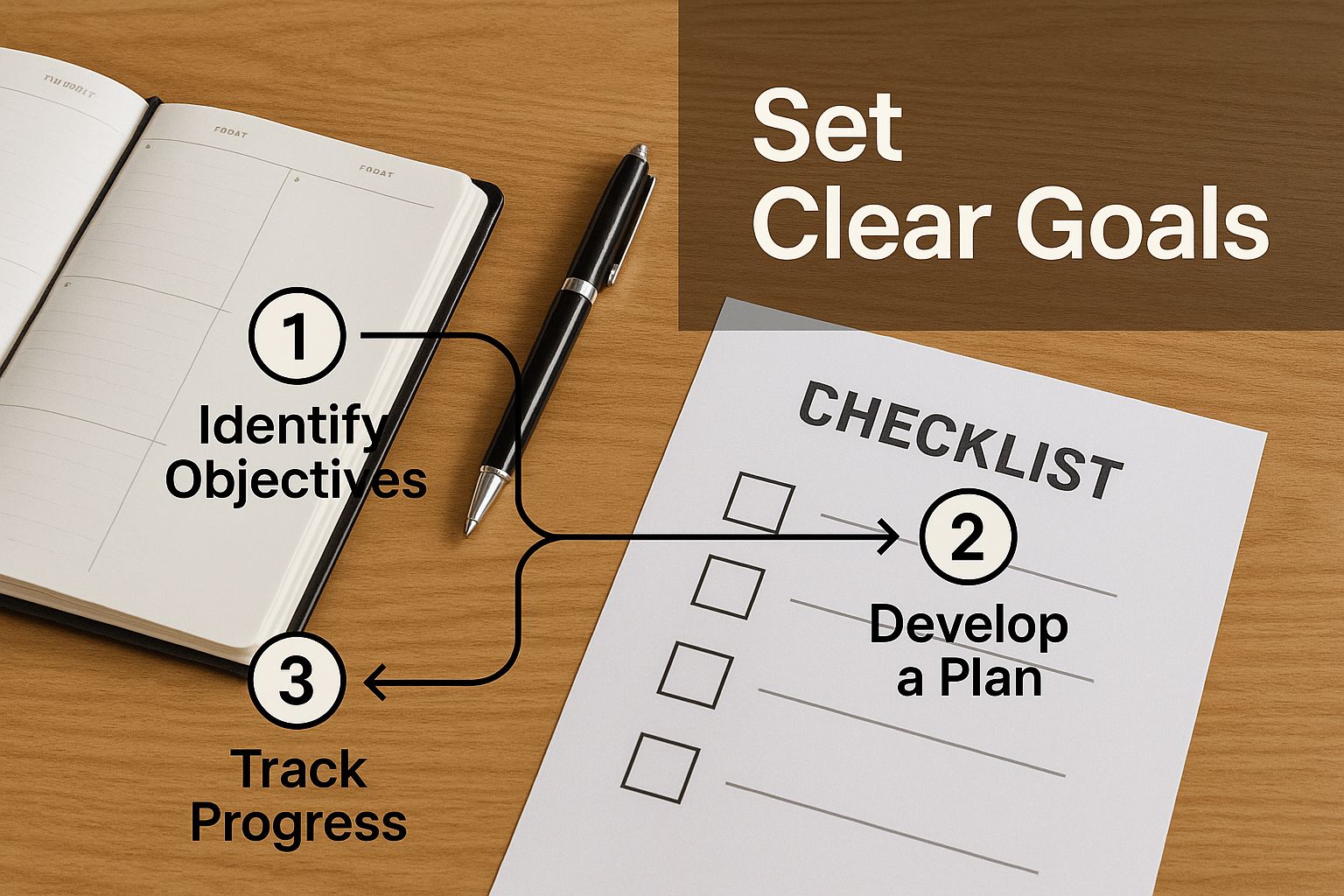Ever felt that sinking feeling when a client says, "This isn't what I imagined"? It's a gut punch that signals a project is about to go off the rails. It almost always stems from a gap between your client's vision and your team's reality. But what if you could close that gap from day one?
The quickest win is to redefine your kickoff meeting. Instead of just talking about deliverables, ask one powerful question: "What does a 'home run' look like for you on this project?" This simple shift from tasks to outcomes is the first step toward building a true partnership and avoiding painful misunderstandings later.
Why Client Expectations Go Off the Rails
Misalignment doesn’t happen overnight. It’s more like a slow, quiet drift caused by unstated assumptions, vague communication, and a collective failure to define what success truly looks like.
Imagine two people trying to build a house with two different blueprints—one in their head and one on paper. The result is always the same: frustration, endless scope creep, and a damaged relationship.
The core issue is that clients often don't know what they don't know. They have a business problem and a desired outcome, but the path to get there is a fog. This is where your expertise becomes crucial, not just in executing the work, but in guiding the entire journey.
The Power of the Kickoff Meeting
Your first meeting is the single best chance you have to prevent future headaches. Seriously. Instead of diving straight into deliverables and timelines, reframe the kickoff as a collaborative discovery session. This isn't just a formality; it’s a strategic move to lock in clarity from day one.
A quick win here is to structure your kickoff around three simple but powerful questions:
What does a "home run" look like for you? This question gets past the specs and uncovers the real business and emotional drivers behind the project.
What are your biggest fears or concerns about this project? This reveals potential roadblocks and anxieties you can get ahead of.
How will we measure success together? This forces a conversation about concrete, tangible metrics, not just vague feelings.
We've seen how quickly things can go sideways, but a few small adjustments can make a world of difference. Here’s a quick-reference table to help you spot common issues and implement fast solutions.
Common Expectation Pitfalls and Quick Wins
Common Pitfall Quick Win Solution Vague Project Goals Use the "Home Run" question in the kickoff to define success in concrete terms. Silent Scope Creep Implement a Decision Log to track all approvals and changes in writing. Communication Breakdowns Set a clear communication cadence (e.g., weekly email updates, bi-weekly calls) from the start. Fear of Pushing Back Frame your pushback as expert guidance. Say, "Based on my experience, this alternative approach might get us to your goal faster. "Misaligned Success Metrics Dedicate part of the kickoff meeting to agreeing on 2-3 specific Key Performance Indicators (KPIs).
This table isn't exhaustive, but tackling these five issues proactively will solve the vast majority of expectation-related problems before they even start.
Remember, you're not just a service provider; you are a partner and an expert guide. Setting this tone is critical, especially when you consider that 54% of customers report having higher expectations for customer service than they did just one year ago. You can read more about these rising standards and how to meet them on GrooveHQ's blog.
Your ability to lead the conversation from the start defines the project's entire trajectory. A structured, partnership-based approach transforms a laundry list of demands into a shared mission. To really perfect this critical initial phase, check out our comprehensive guide on client onboarding best practices.
Now, let's start building the framework to support this partnership.
Building Your Client Alignment Framework
Have you ever felt like you and your client are speaking two different languages? You both agree you want a fantastic outcome, but your paths to get there seem to diverge from day one. This is where unspoken assumptions and vague goals start to fester, eventually leading to scope creep and a whole lot of frustration.
The fastest way to fix this is to stop thinking of project planning as your solo homework assignment. Instead, it’s a collaborative workshop. The real goal isn't just getting a signature on a contract; it's about building a shared understanding from the very beginning. Let's walk through how to create that shared blueprint—what I like to call the project’s constitution.
This whole process kicks off by defining clear, achievable goals. A well-defined plan isn't just paperwork; it's the foundation for everything that follows.

When you have a tangible plan laid out, you transform abstract ideas into a concrete roadmap. It's something both you and your client can hold, point to, and follow together.
Step 1: Document Everything in a Statement of Work
Your most powerful tool in this entire process is a rock-solid Statement of Work (SoW). This document is so much more than a contract. It's the project's official guide, detailing every goal, deliverable, timeline, and responsibility. A well-crafted SoW leaves absolutely no room for misinterpretation.
Make sure your SoW clearly defines these three things:
Project Goals: What specific business result are we aiming for? Don’t just say "build a new website." Get specific: "Increase online sales by 15% within six months of the site's launch."
Specific Deliverables: List out every single thing you will produce. Instead of a vague "social media assets," detail it as "10 static Instagram posts (1080x1080) and 5 animated stories (1080x1920)."
What's Out of Scope: This is just as critical as what’s in scope. Explicitly state what the project does not include. For example, "This project covers website design and development but does not include ongoing monthly SEO services."
A robust SoW is your project's single source of truth. When a client inevitably asks for something extra, you can point back to the document and say, "That's a fantastic idea. It falls outside our current scope, but I'd be happy to put together a separate proposal for it."
This simple pivot reframes potential conflict over scope creep into a new business opportunity. That’s the key to mastering client expectation management.
Step 2: Establish Your Communication Protocols
How, when, and where you'll communicate can be a huge source of anxiety for clients. If they don't know when they'll hear from you, they'll start to worry. Erase that uncertainty by creating a simple Communication Plan and baking it right into your SoW.
This plan should set the rules for:
Frequency: Are updates weekly or bi-weekly?
Channel: Should all requests go through email, or a dedicated project management tool like growlio?
Format: Will your updates be a summary email, a formal PDF report, or maybe a quick Loom video walkthrough?
Response Times: Set clear boundaries, like "We'll respond to all non-urgent inquiries within 24 business hours."
Mini-Case Study: Rescuing a Project with a Clear Framework
A boutique marketing agency was struggling with a client who constantly changed their mind on ad creative, blowing up the timeline and budget. Their initial agreement was a simple, one-page proposal that left way too much open to interpretation.
To get things under control, the agency paused the project and drafted a detailed SoW.
They specified there would be exactly two rounds of revisions for all ad creative. Period.
They established that all feedback had to be submitted through their growlio client portal—no more random texts or emails. You can see where to manage client communication in the growlio UI below.
They added a clause that any additional revisions would be billed at their standard hourly rate.

The result was immediate. The client became much more thoughtful with their feedback. The project got back on schedule, and the agency was fairly compensated for the extra work. This simple framework turned a chaotic mess into a predictable, professional engagement.
By building a strong alignment framework upfront, you turn vague promises into a concrete workflow that protects your team and keeps your client feeling informed and confident.
Mastering Proactive and Transparent Communication
We’ve all been there—staring at an email draft, trying to find just the right words to tell a client about an unexpected delay. It’s a gut-wrenching feeling, built on the fear that one piece of bad news could unravel the entire relationship.
But what if you could deliver tough updates without destroying trust?
The secret isn't some magic phrase. It’s about shifting your entire mindset from reactive damage control to proactive transparency. Instead of waiting for problems to fester, you create a communication rhythm where updates—good, bad, and ugly—are just a normal part of the process. This builds a foundation of trust that can withstand the inevitable bumps in the road.
Great communication is the engine of any successful client relationship. It's not just about talking; it's about creating a predictable, honest dialogue. The link between managing client expectations and retention is crystal clear. Nearly half—a staggering 49%—of customers who left a brand did so because of a poor experience. On the flip side, customers are 2.4 times more likely to stick around if their problems get resolved quickly. You can dig into more data on how customer experience impacts loyalty over on Zendesk's blog.
Step 3: Run Meetings That Actually Work
Let's be honest: most status meetings are a waste of time. They often feel like a formality, a box-ticking exercise that accomplishes nothing. To make them genuinely productive, you need to ditch the vague "how's it going?" approach and bring some real structure to the table.
A truly effective status meeting should always cover three core areas:
Progress Since Last Check-In: Kick things off with a win. Show what you've accomplished and tie it directly back to the project goals.
Upcoming Priorities for Next Week: Clearly outline what’s next on the docket. This shows forward momentum and sets expectations for the immediate future.
Roadblocks and Client Input: This is where the magic happens. It frames challenges not as your failures, but as collaborative problems to solve together.
Step 4: Handle Difficult Conversations with a Framework
So, what do you do when you actually have to deliver bad news? Use the "Fact, Impact, Solution" framework.
Fact (State the issue objectively): "The third-party API we rely on for user authentication has an unexpected outage."
Impact (Explain what it means for the project): "This means the login feature will be delayed by an estimated 3-4 days."
Solution (Present your proactive plan): "We're already building a temporary workaround and are in direct contact with their support team. We'll keep you updated daily on our progress."
This structure removes the emotion, demonstrates ownership, and shows you're already on top of it. It turns a potential crisis into a manageable problem. You can manage and document these conversations effectively using a dedicated platform. Find out more about how a robust CRM can streamline client communication.
The real key is consistency. When clients know they can count on regular, honest updates, they feel like true partners, not just another invoice.
Step 5: Use Technology to Enforce Your Framework
Let's be honest: relying on scattered emails and your own memory to track client work is a recipe for disaster. We've all been there—a critical approval gets buried, a verbal request is forgotten, and suddenly a small issue explodes into a full-blown crisis. This manual approach just doesn't scale.
The real game-changer is when you stop using technology as a digital filing cabinet and start using it to actively enforce your rules of engagement. By moving everything into a unified platform like growlio, you create a single source of truth that leaves no room for confusion for your team or your client.
Build a Single Source of Truth
The foundation of a solid system is centralizing information. Imagine a world where clients can log into a dedicated portal to see project status, review deliverables, and find key documents whenever they want. Those endless "just checking in" emails that derail your day? They practically disappear. This isn't just about making things easier; it's about building trust through radical transparency.
This is where a platform like growlio really shines. You can build a central hub to:
Offer on-demand progress updates: Instead of making them wait for a weekly report, clients can see tasks moving across a Kanban board in real time.
Keep a crystal-clear audit trail: Every message, file, and approval is logged in one thread. This creates an undeniable history of the project, settling any potential disputes before they start.
Automate status reports: Set up reports to go out automatically. This guarantees consistent communication, even when you're swamped with other work.
A centralized dashboard gives everyone an at-a-glance view of project health, outstanding tasks, and financials. No more digging through emails or comparing conflicting spreadsheets.
With a tool like growlio, clients can view project status, financials, and communications in one dashboard, reducing check-in emails.
When both you and your client are looking at the same data, alignment becomes effortless.
This shift toward structured client management is part of a much bigger trend. The global customer experience management market is already valued at USD 9.35 billion and is expected to keep growing. It's clear that businesses are investing heavily in shaping the client journey, and you can learn more about how analytics are transforming client management in this fascinating report.
Pro Tip: Use Your Data as a "Client Health" Monitor
For advanced users, your platform's data becomes an invaluable early warning system. In growlio, for instance, you can track communication patterns to spot at-risk clients. Is a client suddenly firing off messages after weeks of radio silence? Are they submitting one scope change after another? These are early warning signs of misalignment. This lets you step in and have a conversation before a small frustration turns into a reason they leave.
By using technology to build and enforce your framework, you move from hoping expectations are met to ensuring they are.
Your Next Steps Toward Perfect Client Alignment
So, you've made it this far. That tells me you’re serious about moving past that sinking feeling of a project going off the rails because everyone was on a different page. The good news is that learning how to manage client expectations isn't some mystical art. It’s a practical skill, and it’s built on having a solid process.
You now have a 5-step framework you can use to put an end to scope creep and build partnerships that last.

Your Alignment Checklist
Here’s a quick checklist to help you put these ideas into practice today:
Step 1: Define Success Early: Don't leave the kickoff meeting until everyone agrees on what a "win" looks like. Get those KPIs down on paper.
Step 2: Document Everything: Your Statement of Work (SoW) needs to be airtight. Be explicit about what's included and, just as importantly, what's not.
Step 3: Communicate Proactively: Set a communication schedule and honor it.
Step 4: Handle Bad News Constructively: When issues arise, use the "Fact, Impact, Solution" model to keep things constructive.
Step 5: Centralize Everything: Use a platform like growlio to create a single source of truth for tasks, communication, and approvals.
The biggest thing to remember is that managing expectations isn't a "set it and forget it" task. It’s a continuous process. You're building a system of transparency that underpins every single interaction you have with your client.
Getting this right from the start means capturing all the critical information from the very first touchpoint. A great way to nail this is to learn how to build an effective lead capture form that sets the stage for clarity long before a contract is signed.
You've got the strategies. Now it’s time to pair them with the right tools. Ready to stop chasing emails and build a system that works?
Start a free growlio account and experience firsthand how a dedicated platform can systemize your entire client management process.
Frequently Asked Questions
Even with a perfect plan, client work can get messy. Things come up, plans change, and you have to think on your feet. From my experience, here are some of the most common snags you'll run into and how to handle them without breaking a sweat.
What’s the Best Way to Handle a Client Who Constantly Changes Their Mind?
We've all been there. The project is humming along, and then another "small tweak" or "new idea" lands in your inbox, threatening to derail everything. This kind of scope creep usually signals that the initial discovery phase wasn't quite tight enough.
The best defense is a good offense: a rock-solid change request process. When the client asks for something new, don't just agree to it. Instead, gently guide them back to the established system. Try saying something like, "That's an interesting idea. Could you please submit that through our portal as a formal change request? As soon as we get that, I can work up an updated timeline and quote for you."
This simple phrase is powerful. It does two things at once:
It reinforces the original project scope without being confrontational.
It immediately connects their new idea to real-world consequences—more time and more money—which often makes clients more deliberate about what they really need.
How Do You Reset Expectations Mid-Project When Things Go Wrong?
That sinking feeling when you realize a project is off track is awful. But trust me, hiding the problem is always worse. The moment you spot an issue, you need to be proactive and schedule what I call a "course correction" meeting. Don't try to handle this over email. A face-to-face conversation, even if it's virtual, is essential for rebuilding trust.
Here’s a simple, honest way to kick off that conversation:
"Thanks for making the time to chat. I wanted to get in front of a challenge we've run into with [mention the specific issue]. At our current pace, we aren't going to hit our original goal of [mention the goal], and I want to walk you through our plan to get everything back on course."
This approach works because you’re taking ownership. You’re not blaming anyone; you’re positioning yourself as a proactive partner focused on finding a solution together. It completely changes the tone from "Houston, we have a problem" to "Okay, let's solve this."
How Much Detail Is Too Much in a Project Kickoff?
The project kickoff is a balancing act. You need to provide enough information to build confidence, but not so much that you overwhelm your client with technical details. The goal is clarity, not exhaustion.
My rule of thumb is to focus on the "what" and the "why," leaving most of the "how" for your internal team.
Just Right: Clearly define the top 3-5 project goals, list the key deliverables and their due dates, and walk them through how and when you'll communicate.
Way Too Much: Going line-by-line through your Asana task list, explaining the nuances of your internal team structure, or getting lost in technical jargon.
Stick to the high-level information your client needs to make good decisions and feel secure. You can always dive deeper into the weeds later if they ask for more detail.
You have the strategies to build stronger, more profitable client partnerships. growlio provides the tools to put them into action.
Ready to systematize your client management? Start a free growlio account today.
